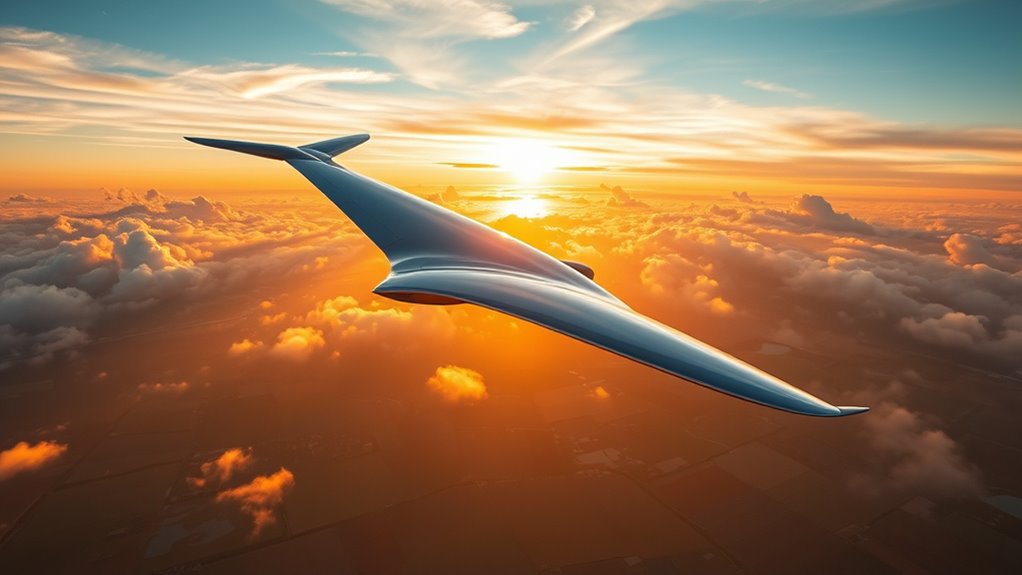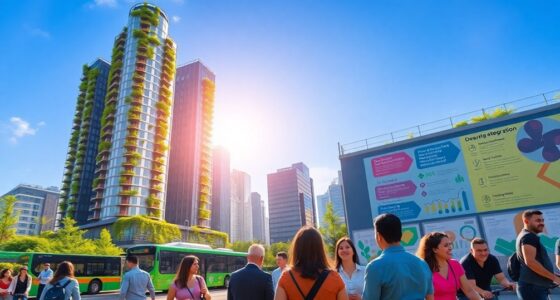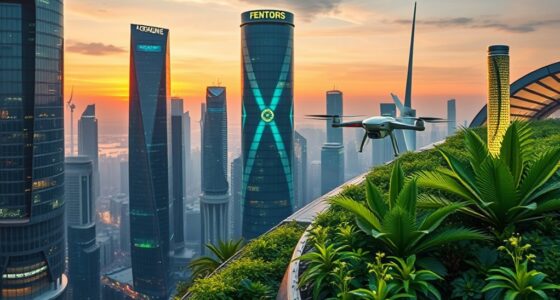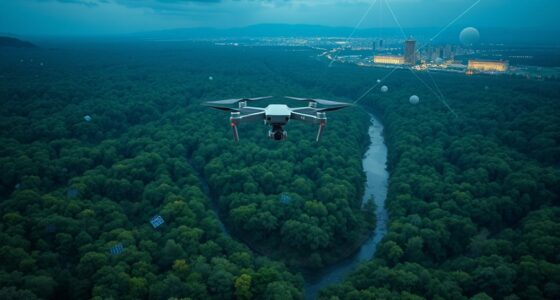By 2025, you’ll see big changes in how planes fly without fossil fuels. Electric aircraft are becoming more common for short and medium routes thanks to advances in battery tech. Hydrogen-powered planes are also gaining momentum for longer flights, with fuel cells emitting only water vapor. These innovations are shaping a greener future for aviation. If you want to learn what’s next for sustainable flight, there’s more to discover.
Key Takeaways
- Electric aircraft are increasingly suitable for short to medium routes due to advancements in battery technology.
- Hydrogen-powered planes are being developed for longer flights, with fuel cells emitting only water vapor.
- Major aerospace companies are investing in hydrogen prototypes, accelerating commercial adoption.
- Synthetic and biofuels continue to play a crucial role in reducing emissions and supporting cleaner aviation.
- Industry goals aim for fossil fuel-free flying by 2025, driven by innovations in electric, hydrogen, and alternative fuels.
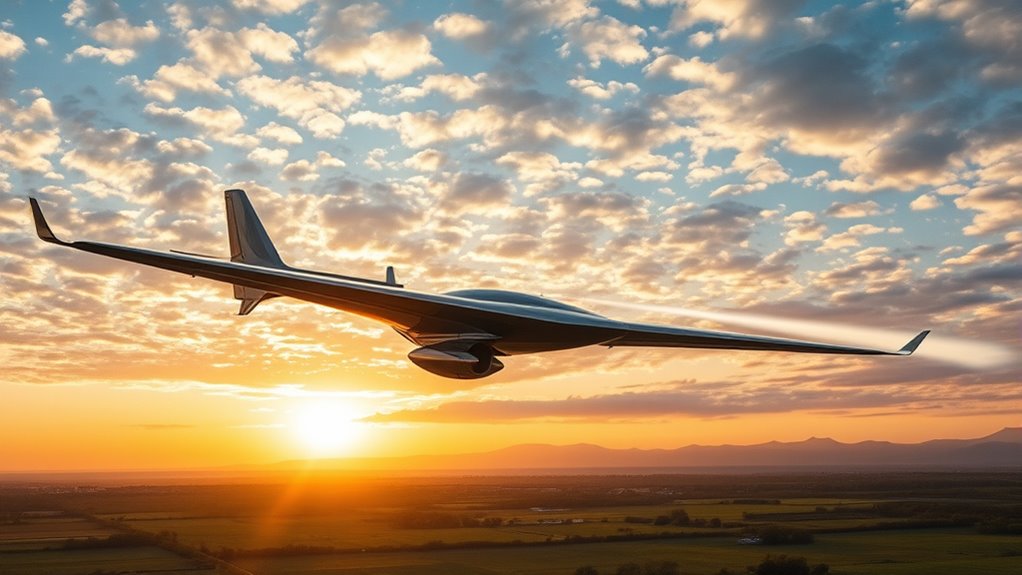
Have you ever wondered if flying can be sustainable? As the world pushes for greener solutions, the aviation industry is exploring innovative ways to reduce its environmental impact. One promising area is sustainable aviation, which focuses on developing aircraft that operate without relying on traditional fossil fuels. Instead, researchers and companies are turning to alternative fuels like biofuels, synthetic fuels, and even hydrogen to power flights. These alternatives aim to cut carbon emissions considerably and make air travel more eco-friendly.
Exploring sustainable aviation with biofuels, synthetic fuels, and hydrogen to make flying more eco-friendly.
In recent years, advancements in electric and hydrogen planes have accelerated, bringing us closer to a future where flying without fossil fuels becomes a reality. Electric planes are particularly appealing for short to medium routes, thanks to improvements in battery technology that now allow for longer flights with more passengers. With lighter, more efficient batteries, these aircraft can operate sustainably without sacrificing performance or safety. As you consider your next trip, it’s exciting to think about how electric planes could soon become common, making your travel greener and more responsible.
Hydrogen-powered aircraft are also gaining momentum, especially for longer flights. Unlike batteries, which can be heavy and limit range, hydrogen offers a high energy density and can be stored in tanks that are lighter than traditional fuel. When used in fuel cells, hydrogen generates electricity to power the aircraft’s engines, emitting only water vapor as a byproduct. This process considerably reduces greenhouse gases, aligning with the goal of sustainable aviation. Major aerospace companies are investing in hydrogen research, developing prototypes that could soon be flying commercially.
The shift towards alternative fuels is central to making these innovations viable. Synthetic fuels made from renewable energy sources can be blended with traditional jet fuel or used pure, providing an immediate way to lower emissions. Biofuels derived from algae or waste biomass also offer promising options, as they can be produced sustainably and with minimal land use. These fuels help airlines meet stricter environmental standards while maintaining operational efficiency. As you look ahead, it’s encouraging to see the industry embrace these cleaner alternatives as part of its commitment to sustainability.
Frequently Asked Questions
What Are the Main Challenges for Electric and Hydrogen Planes?
You face several challenges with electric and hydrogen planes. Battery technology needs to improve for longer flights, requiring more energy-dense solutions. Hydrogen storage remains complex and potentially unsafe. Additionally, government regulation can slow progress, as safety standards and infrastructure development lag behind technological advances. Overcoming these hurdles is essential for making electric and hydrogen planes viable options for sustainable, fossil fuel-free air travel.
How Long Are the Flight Ranges for These New Aircraft?
You might think electric and hydrogen planes can’t cover long distances, but advances in battery technology are closing that gap. Today, these aircraft can fly approximately 300-500 miles, enough for regional routes, while hydrogen planes could reach up to 1,000 miles. Passengers stay comfortable thanks to quieter engines and smoother flights. As technology improves, expect longer ranges and better comfort, making eco-friendly flying more practical than ever.
What Infrastructure Is Needed to Support Hydrogen Fueling?
You’ll need dedicated hydrogen fueling stations with specialized infrastructure to support these planes. This includes hydrogen storage tanks that safely hold the fuel before fueling, along with pipelines and dispensing systems designed for high pressure. Airports will have to invest in these fueling stations, ensuring they’re strategically placed for efficiency and safety. Upgrading infrastructure is essential for smooth, widespread adoption of hydrogen-powered aircraft, making flights more sustainable and reducing reliance on fossil fuels.
How Will These Planes Impact Airline Ticket Prices?
You might notice airline ticket prices changing as electric and hydrogen planes enter the market. These planes could lower operating costs, but initial investments and infrastructure upgrades might increase prices temporarily. Over time, increased market competition and technological advancements could drive prices down, making flights more affordable. The overall cost implications depend on how quickly airlines adopt these new technologies and how infrastructure investments balance out with savings in fuel and maintenance.
Are There Any Safety Concerns With Hydrogen-Powered Aircraft?
You might wonder about hydrogen safety on upcoming aircraft. While hydrogen offers eco-friendly benefits, safety concerns exist, like potential leaks or flammability. Engineers focus on electric reliability and rigorous safety protocols to prevent accidents. With advances in technology and testing, these risks are minimized, making hydrogen-powered planes safer than ever. Your peace of mind depends on continued innovation and strict safety standards, ensuring safe, sustainable flights in the future.
Conclusion
As you envision a future where skies are clearer and journeys gentler, it’s exciting to see innovations gently guiding us toward cleaner skies. By embracing electric and hydrogen planes, you’re helping to nurture a world where flying becomes more harmonious with nature’s rhythm. With each step forward, you’re contributing to a horizon where travel feels lighter, more sustainable, and beautifully in tune with the planet’s gentle pulse. The sky’s the limit for a greener tomorrow.
